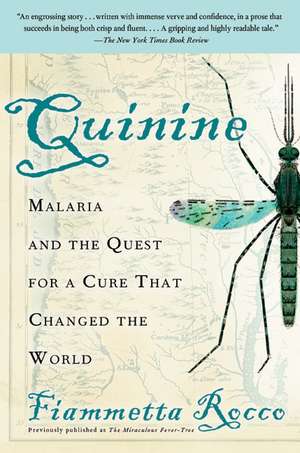Quinine: Malaria and the Quest for a Cure That Changed the World
Autor Fiammetta Roccoen Paperback – 16 aug 2004
Malaria kills someone every 12 minutes in Africa. Now known mostly as a disease of the tropics, malaria led to the demise of the Roman Empire 2,000 years ago and ravaged Europe for years afterwards. At the start of the 17th century, Jesuit priests developed quinine, an alkaloid made out of the bitter red bark of the cinchona tree from the Andes. When quinine arrived in Europe, the Protestant powers resisted the medicine fearing that it was a Popish poison. Quinine’s reputation improved, however, when King Charles II was cured of malaria through its offices. Through the centuries, wars were fought to control the supply-through the building of the Panama Canal and into WWII--until Americans synthesized quinine for the first time in 1944.
Rocco describes the ravages of the disease, the search for a cure, and the quest to steal and smuggle cinchona seeds out of South America. The Miraculous Fever Tree deftly illuminates the religious and scientific rivalries, intrepid exploration and colonization evinced by the search for quinine.
Preț: 98.73 lei
Nou
Puncte Express: 148
Preț estimativ în valută:
18.89€ • 19.65$ • 15.60£
18.89€ • 19.65$ • 15.60£
Carte disponibilă
Livrare economică 24 martie-07 aprilie
Preluare comenzi: 021 569.72.76
Specificații
ISBN-13: 9780060959005
ISBN-10: 0060959002
Pagini: 384
Dimensiuni: 135 x 203 x 22 mm
Greutate: 0.3 kg
Ediția:Reprint
Editura: HarperCollins Publishers
Colecția HarperPerennial
ISBN-10: 0060959002
Pagini: 384
Dimensiuni: 135 x 203 x 22 mm
Greutate: 0.3 kg
Ediția:Reprint
Editura: HarperCollins Publishers
Colecția HarperPerennial
Textul de pe ultima copertă
Quinine: The Jesuits discovered it. The Protestants feared it. The British vied with the Dutch for it, and the Nazis seized it. Because of quinine, medicine, warfare, and exploration were changed forever.
For more than one thousand years, there was no cure for malaria. In 1623, after ten cardinals and hundreds of their attendants died in Rome while electing Urban VII the new pope, he announced that a cure must be found. He encouraged Jesuit priests establishing new missions in Asia and in South America to learn everything they could about how the local people treated the disease, and in 1631, an apothecarist in Peru named Agostino Salumbrino dispatched a new miracle to Rome. The cure was quinine, an alkaloid made from the bitter red bark of the cinchona tree.
From the quest of the Englishmen who smuggled cinchona seeds out of South America to the way in which quinine opened the door to Western imperial adventure in Asia, Africa, and beyond, and to malaria's effects even today, award-winning author Fiammetta Rocco deftly chronicles the story of this historically ravenous disease.
For more than one thousand years, there was no cure for malaria. In 1623, after ten cardinals and hundreds of their attendants died in Rome while electing Urban VII the new pope, he announced that a cure must be found. He encouraged Jesuit priests establishing new missions in Asia and in South America to learn everything they could about how the local people treated the disease, and in 1631, an apothecarist in Peru named Agostino Salumbrino dispatched a new miracle to Rome. The cure was quinine, an alkaloid made from the bitter red bark of the cinchona tree.
From the quest of the Englishmen who smuggled cinchona seeds out of South America to the way in which quinine opened the door to Western imperial adventure in Asia, Africa, and beyond, and to malaria's effects even today, award-winning author Fiammetta Rocco deftly chronicles the story of this historically ravenous disease.
Recenzii
“An absorbing and superbly researched history of malaria and its cure.” — Sunday Times (London)
“Ms. Rocco tells her four-century saga briskly, with a confident blend of scholarship and memoir.” — Wall Street Journal
“Lively, elegantly written and often fascinating” — Evening Standard (London)
“Snappy and sharp...it’s almost a crime that so heinous a disease should be treated to so grand a biography.” — Kirkus Reviews
“An engrossing story...written with immense verve and confidence...crisp and fluent...a gripping and highly readable tale.” — New York Times Book Review
“Ms. Rocco tells her four-century saga briskly, with a confident blend of scholarship and memoir.” — Wall Street Journal
“Lively, elegantly written and often fascinating” — Evening Standard (London)
“Snappy and sharp...it’s almost a crime that so heinous a disease should be treated to so grand a biography.” — Kirkus Reviews
“An engrossing story...written with immense verve and confidence...crisp and fluent...a gripping and highly readable tale.” — New York Times Book Review
Notă biografică
Fiammetta Rocco was raised in Kenya. Her grandfather, her father and she herself all suffered from malaria. Ms. Rocco's investigative journalism has won a number of awards in the United States and in Britain. She lives in London, where she is the literary editor of the Economist. This is her first book.




